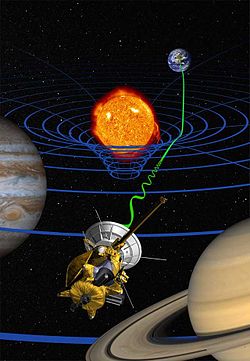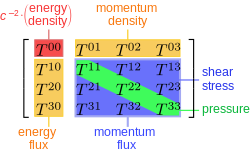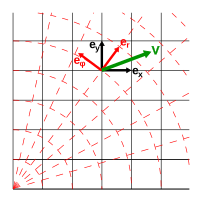广义相对论中的数学入门
| 广义相对论 |
|---|
 |
广义相对论所使用的数学很复杂。牛顿的运动理论中,物体做加速度运动时,其长度和时间流逝的速率保持定值,这表示牛顿力学中的许多问题用代数就能解决。然而,相对论中的物体在运动速度接近光速时,长度和时间流逝的速率会有可观的改变,这表示要计算物体的运动必须用上更多变数和复杂的数学,如向量、张量、伪张量、曲线座标等概念。
向量与张量
[编辑]向量
[编辑]
在数学、物理学及工程学中,欧几里得向量(有时也称为“几何向量”[1]、“空间向量”[2],或单称“向量”)是同时有量值(长度)和方向的几何对象。一个向量将点“搬运”至点;向量的拉丁文“vector”意思为“搬运东西的东西”。[3]向量的量值就是两点之间的距离,方向则为到的位移方向。很多实数的代数运算,像加、减、乘、逻辑非,和向量的运算很类似,运算也遵守相似的代数法则,如交换律、结合律、分配律。
张量
[编辑]
张量将向量的概念延伸至额外的维度。标量是没有方向的量,是单纯的数字,在图上以点来表示,是零维的物件。向量则有量值和方向,在图上以线呈现,是一维的物件。张量延伸了向量的概念,一个二维的张量称为二阶张量,可以看成一组相关的向量,在一个平面上的多个方向移动。
应用
[编辑]向量在物理科学里很基础。他们可用来代表所有同时有量值和方向的量,例如速度。速度的量值为速率。举例而言,每秒五米向上的速度可以向量(0, 5)表示(在二维以轴的正方向表示向上)。力的量也能以向量表示,因为它有量值和方向。向量也能描述很多其他的物理量,如位移、加速度、动量和角动量。其他物理向量,如电场和磁场,以物理空间中所有点的向量系统表示,也就是向量场。
张量在物理中也有延伸应用:
- 电磁学中的电磁张量(或法拉第张量)
- 在连续介质力学中的形变描述形变和应变张量的有限应变张量
- 电容率和电极化率是各向异性介质中的张量
- 广义相对论中的应力-能量张量,用来表示动量的通量
- 球张量算符是球座标系中量子角动量算符的特征函数
- 扩散张量是扩散磁振造影的基础,代表生物环境中的扩散率
维度
[编辑]广义相对论需要用到四维向量,或称四向量。这四维为长、宽、高、时间。其中的“点”代表事件,因为它同时包含地点和时间。类似向量,相对论中的张量也需要四维。其中一个例子就是黎曼曲率张量。
座标转换
[编辑]In physics, as well as mathematics, a vector is often identified with a tuple, or list of numbers, which depend on some auxiliary coordinate system or reference frame. When the coordinates are transformed, for example by rotation or stretching of the coordinate system, then the components of the vector also transform. The vector itself has not changed, but the reference frame has, so the components of the vector (or measurements taken with respect to the reference frame) must change to compensate.
The vector is called covariant or contravariant depending on how the transformation of the vector's components is related to the transformation of coordinates.
- Contravariant vectors are "regular vectors" with units of distance (such as a displacement) or distance times some other unit (such as velocity or acceleration). For example, in changing units from meters to millimeters, a displacement of 1 m becomes 1000 mm.
- Covariant vectors, on the other hand, have units of one-over-distance (typically such as gradient). For example, in changing again from meters to millimeters, a gradient of 1 K/m becomes 0.001 K/mm.
In Einstein notation, contravariant vectors and components of tensors are shown with superscripts, e.g. xi, and covariant vectors and components of tensors with subscripts, e.g. xi. Indices are "raised" or "lowered" by multiplication by an appropriate matrix, often the identity matrix.
Coordinate transformation is important because relativity states that there is no one correct reference point in the universe. On earth, we use dimensions like north, east, and elevation, which are used throughout the entire planet. There is no such system for space. Without a clear reference grid, it becomes more accurate to describe the four dimensions as towards/away, left/right, up/down and past/future. As an example event, take the signing of the Declaration of Independence. To a modern observer on Mount Rainier looking east, the event is ahead, to the right, below, and in the past. However, to an observer in medieval England looking north, the event is behind, to the left, neither up nor down, and in the future. The event itself has not changed, the location of the observer has.
斜轴
[编辑]An oblique coordinate system is one in which the axes are not necessarily orthogonal to each other; that is, they meet at angles other than right angles. When using coordinate transformations as described above, the new coordinate system will often appear to have oblique axes compared to the old system.
非张量
[编辑]A nontensor is a tensor-like quantity that behaves like a tensor in the raising and lowering of indices, but that does not transform like a tensor under a coordinate transformation. For example, Christoffel symbols cannot be tensors themselves if the coordinates don't change in a linear way.
In general relativity, one cannot describe the energy and momentum of the gravitational field by an energy–momentum tensor. Instead, one introduces objects that behave as tensors only with respect to restricted coordinate transformations. Strictly speaking, such objects are not tensors at all. A famous example of such a pseudotensor is the Landau–Lifshitz pseudotensor.
曲线座标和弯曲时空
[编辑]
Curvilinear coordinates are coordinates in which the angles between axes can change from point to point. This means that rather than having a grid of straight lines, the grid instead has curvature.
A good example of this is the surface of the Earth. While maps frequently portray north, south, east and west as a simple square grid, that is not in fact the case. Instead, the longitude lines running north and south are curved and meet at the north pole. This is because the Earth is not flat, but instead round.
In general relativity, gravity has curvature effects on the four dimensions of the universe. A common analogy is placing a heavy object on a stretched out rubber sheet, causing the sheet to bend downward. This curves the coordinate system around the object, much like an object in the universe curves the coordinate system it sits in. The mathematics here are conceptually more complex than on Earth, as it results in four dimensions of curved coordinates instead of three as used to describe a curved 2D surface.
平行移动
[编辑]
高维空间中的区间
[编辑]In a Euclidean space, the separation between two points is measured by the distance between the two points. The distance is purely spatial, and is always positive. In spacetime, the separation between two events is measured by the invariant interval between the two events, which takes into account not only the spatial separation between the events, but also their temporal separation. The interval, s2, between two events is defined as:
- (spacetime interval),
where c is the speed of light, and Δr and Δt denote differences of the space and time coordinates, respectively, between the events. The choice of signs for s2 above follows the space-like convention (−+++). A notation like Δr2 means (Δr)2. The reason s2 is called the interval and not s is that s2 can be positive, zero or negative.
Spacetime intervals may be classified into three distinct types, based on whether the temporal separation (c2Δt2) or the spatial separation (Δr2) of the two events is greater: time-like, light-like or space-like.
Certain types of world lines are called geodesics of the spacetime – straight lines in the case of Minkowski space and their closest equivalent in the curved spacetime of general relativity. In the case of purely time-like paths, geodesics are (locally) the paths of greatest separation (spacetime interval) as measured along the path between two events, whereas in Euclidean space and Riemannian manifolds, geodesics are paths of shortest distance between two points.[4][5] The concept of geodesics becomes central in general relativity, since geodesic motion may be thought of as "pure motion" (inertial motion) in spacetime, that is, free from any external influences.
协变导数
[编辑]The covariant derivative is a generalization of the directional derivative from vector calculus. As with the directional derivative, the covariant derivative is a rule, which takes as its inputs: (1) a vector, u, (along which the derivative is taken) defined at a point P, and (2) a vector field, v, defined in a neighborhood of P. The output is a vector, also at the point P. The primary difference from the usual directional derivative is that the covariant derivative must, in a certain precise sense, be independent of the manner in which it is expressed in a coordinate system.
平行移动
[编辑]Given the covariant derivative, one can define the parallel transport of a vector v at a point P along a curve γ starting at P. For each point x of γ, the parallel transport of v at x will be a function of x, and can be written as v(x), where v(0) = v. The function v is determined by the requirement that the covariant derivative of v(x) along γ is 0. This is similar to the fact that a constant function is one whose derivative is constantly 0.
克里斯多福符号
[编辑]The equation for the covariant derivative can be written in terms of Christoffel symbols. The Christoffel symbols find frequent use in Einstein's theory of general relativity, where spacetime is represented by a curved 4-dimensional Lorentz manifold with a Levi-Civita connection. The Einstein field equations – which determine the geometry of spacetime in the presence of matter – contain the Ricci tensor. Since the Ricci tensor is derived from the Riemann tensor, which can be written in terms of Christoffel symbols, a calculation of the Christoffel symbols is essential. Once the geometry is determined, the paths of particles and light beams are calculated by solving the geodesic equations in which the Christoffel symbols explicitly appear.
测地线
[编辑]In general relativity, a geodesic generalizes the notion of a "straight line" to curved spacetime. Importantly, the world line of a particle free from all external, non-gravitational force, is a particular type of geodesic. In other words, a freely moving or falling particle always moves along a geodesic.
In general relativity, gravity can be regarded as not a force but a consequence of a curved spacetime geometry where the source of curvature is the stress–energy tensor (representing matter, for instance). Thus, for example, the path of a planet orbiting around a star is the projection of a geodesic of the curved 4-dimensional spacetime geometry around the star onto 3-dimensional space.
A curve is a geodesic if the tangent vector of the curve at any point is equal to the parallel transport of the tangent vector of the base point.
曲率张量
[编辑]The Riemann tensor tells us, mathematically, how much curvature there is in any given region of space. Contracting the tensor produces 3 different mathematical objects:
- The Riemann curvature tensor: Rρσμν, which gives the most information on the curvature of a space and is derived from derivatives of the metric tensor. In flat space this tensor is zero.
- The Ricci tensor: Rσν, comes from the need in Einstein's theory for a curvature tensor with only 2 indices. It is obtained by averaging certain portions of the Riemann curvature tensor.
- The scalar curvature: R, the simplest measure of curvature, assigns a single scalar value to each point in a space. It is obtained by averaging the Ricci tensor.
The Riemann curvature tensor can be expressed in terms of the covariant derivative.
The Einstein tensor G is a rank-2 tensor defined over pseudo-Riemannian manifolds. In index-free notation it is defined as
where R is the Ricci tensor, g is the metric tensor and R is the scalar curvature. It is used in the Einstein field equations.
应力-能量张量
[编辑]
The stress–energy tensor (sometimes stress–energy–momentum tensor or energy–momentum tensor) is a tensor quantity in physics that describes the density and flux of energy and momentum in spacetime, generalizing the stress tensor of Newtonian physics. It is an attribute of matter, radiation, and non-gravitational force fields. The stress–energy tensor is the source of the gravitational field in the Einstein field equations of general relativity, just as mass density is the source of such a field in Newtonian gravity.
爱因斯坦方程
[编辑]The Einstein field equations (EFE) or Einstein's equations are a set of 10 equations in Albert Einstein's general theory of relativity which describe the fundamental interaction of gravitation as a result of spacetime being curved by matter and energy.[6] First published by Einstein in 1915[7] as a tensor equation, the EFE equate local spacetime curvature (expressed by the Einstein tensor) with the local energy and momentum within that spacetime (expressed by the stress–energy tensor).[8]
The Einstein Field Equations can be written as
where Gμν is the Einstein tensor and Tμν is the stress–energy tensor.
This implies that the curvature of space (represented by the Einstein tensor) is directly connected to the presence of matter and energy (represented by the stress–energy tensor).
史瓦西解与黑洞
[编辑]In Einstein's theory of general relativity, the Schwarzschild metric (also Schwarzschild vacuum or Schwarzschild solution), is a solution to the Einstein field equations which describes the gravitational field outside a spherical mass, on the assumption that the electric charge of the mass, the angular momentum of the mass, and the universal cosmological constant are all zero. The solution is a useful approximation for describing slowly rotating astronomical objects such as many stars and planets, including Earth and the Sun. The solution is named after Karl Schwarzschild, who first published the solution in 1916.
According to Birkhoff's theorem, the Schwarzschild metric is the most general spherically symmetric, vacuum solution of the Einstein field equations. A Schwarzschild black hole or static black hole is a black hole that has no charge or angular momentum. A Schwarzschild black hole is described by the Schwarzschild metric, and cannot be distinguished from any other Schwarzschild black hole except by its mass.
参见
[编辑]注释
[编辑]- ^ Ivanov 2001[查无此文]
- ^ Heinbockel 2001[查无此文]
- ^ From Latin vectus, perfect participle of vehere, "to carry". For historical development of the word vector, see vector n.. 牛津英语词典 (第三版). 牛津大学出版社. 2005-09 (英语). and Jeff Miller. Earliest Known Uses of Some of the Words of Mathematics. [2007-05-25]. (原始内容存档于2015-09-05).
- ^ This characterization is not universal: both the arcs between two points of a great circle on a sphere are geodesics.
- ^ Berry, Michael V. Principles of Cosmology and Gravitation. CRC Press. 1989: 58. ISBN 0-85274-037-9. Extract of page 58, caption of Fig. 25
- ^ Einstein, Albert. The Foundation of the General Theory of Relativity. Annalen der Physik. 1916, 354 (7): 769. Bibcode:1916AnP...354..769E. doi:10.1002/andp.19163540702. (原始内容 (PDF)存档于2006-08-29).
- ^ Einstein, Albert. Die Feldgleichungen der Gravitation. Sitzungsberichte der Preussischen Akademie der Wissenschaften zu Berlin. November 25, 1915: 844–847 [2006-09-12]. (原始内容存档于2016-10-27).
- ^ Misner, Charles W.; Thorne, Kip S.; Wheeler, John Archibald. Gravitation. San Francisco: W. H. Freeman. 1973. ISBN 978-0-7167-0344-0. Chapter 34, p 916
参考文献
[编辑]- P. A. M. Dirac. General Theory of Relativity. Princeton University Press. 1996. ISBN 0-691-01146-X.
- Misner, Charles; Thorne, Kip S.; Wheeler, John Archibald. Gravitation. San Francisco: W. H. Freeman. 1973. ISBN 0-7167-0344-0.
- Landau, L. D.; Lifshitz, E. M. Classical Theory of Fields (Fourth Revised English Edition). Oxford: Pergamon. 1975. ISBN 0-08-018176-7.
- R. P. Feynman; F. B. Moringo; W. G. Wagner. Feynman Lectures on Gravitation. Addison-Wesley. 1995. ISBN 0-201-62734-5.
- Einstein, A. Relativity: The Special and General Theory. New York: Crown. 1961. ISBN 0-517-02961-8.








